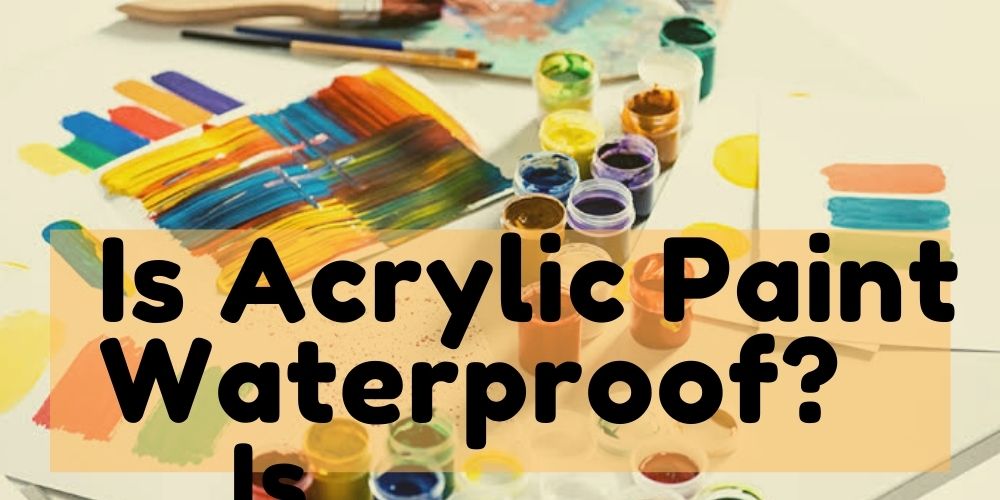Because of its vast spectrum of colors, quick drying time, and ease of cleanup, acrylic paint is a popular medium among crafters and painters. Acrylic paint is a flexible addition to your creative equipment since it can be used to create designs on a range of media, including canvas, wood, metal, cloth, and ceramics.
But can you use acrylic paint on glass?
Well, Acrylic is a flexible material that may be used for a variety of projects, including glass, windows, and even stained glass. It can be painted on glass, but it won’t be as simple as painting on canvas. Unfortunately, acrylic paints will only adhere to glass if you use a specific medium and properly prepare your glass surface.
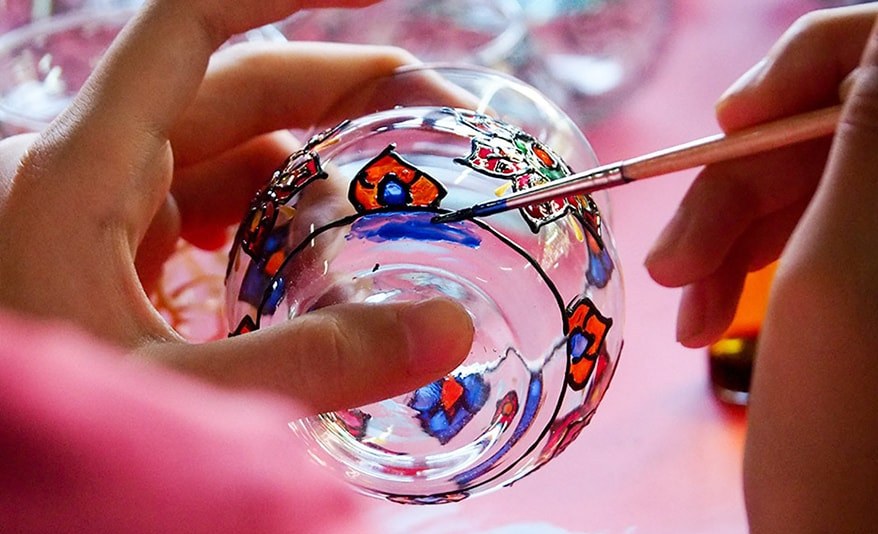
Acrylic paints stick better on the surfaces that are porous like canvas or wood, while non-porous, non-absorbent surfaces like glass may rip off.
Can You Use Acrylic Paint on Glass?
The Actual Answer is:
Acrylic paint may be applied on glass since it is such a flexible medium. However, considerable preparation is required, as well as a particular paint (such as Folk Art) that will adhere to a smooth glass surface without peeling.
You’ll also need to protect the paint on the glass to ensure that it doesn’t wash away and remains firmly adhered to the surface.
There are a few things to bear in mind while painting acrylic on glass. First, acrylic paints are incompatible with glass surfaces without adequate priming and the use of the appropriate paint and medium, and will tend to smear and/or adhere loosely to the surface, making cleanup difficult or impossible.
Secondly, glass is a non-porous, difficult-to-seal surface on which acrylic paints do not stick effectively, resulting in the acrylic paint coating flaking off after a short period of time.
Why? Because glass is non-porous, the paint does not seep into the surface and instead rests on top. Your painting may be removed if you haven’t sealed it properly.
Acrylic paint and glass work well together as a decorative medium. So be cautious when using glass cookware or painting glass surfaces that will come into close contact with food.
Things to Consider Before Choosing the Acrylic Paint On Glass?
Basically, no matter what surface you’re going to paint on, the basic criteria you should consider when selecting a decent acrylic paint are universal.
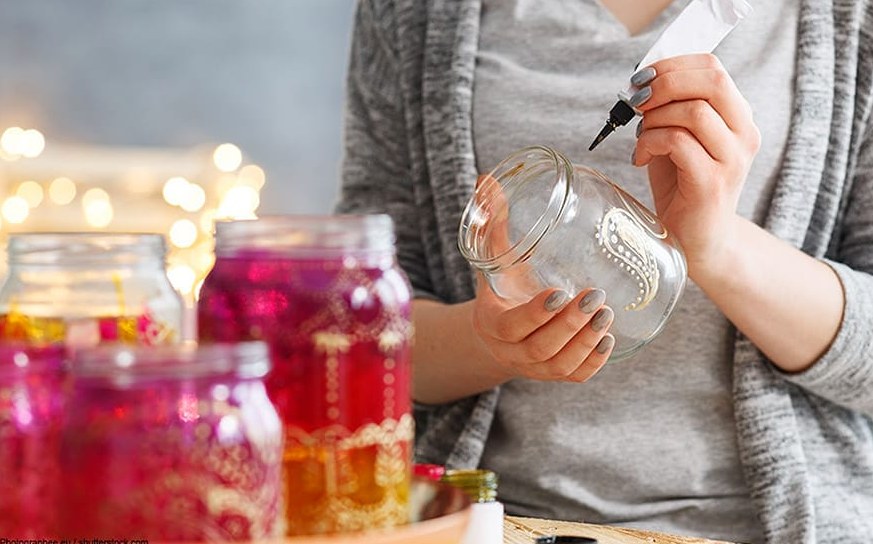
Type of Paint
Enamel paints are acrylic-based, but they adhere to glass better and are easier to seal with clear varnish or glass protector spray.
Check the Manufacturer Label
Acrylic paint is a type of water-based paint. Acrylics, on the other hand, may contain other components such as latex, water, and preservatives. The label will also indicate if the paint is slow-drying, opaque, or clear, as well as any other pertinent information.
Some paint makers will state whether or not the paint is suitable for a certain surface. So, Check the Manufacturer Label before you purchase them. Look for the word “glass”.
Brand and quality are important considerations to be kept in mind. Acrylic paints with better quality acrylic are more durable than acrylic paints with lower quality acrylic. Also, before selecting the acrylic paint that you require, see if you can obtain a sample or consult a color chart. Student-grade acrylic paint may also work for craft projects.
Transparency
By their very nature, certain colours are more translucent than others. Acrylics are designed to be more semi-opaque than gouache, acting more like oil paint. Opacity is still used to fix errors and form patterns while painting. The opaque color appears to be brighter and thicker.
Lightfastness
Lightfastness refers to how effectively paint resists UV over time, or simply how quickly it fades. Lightfastness is graded on a scale of one to four, with levels one and two being excellent. However, craft and student-grade paints rarely specify lightfastness, and only artist-grade paints like Liquitex are recommended for craft applications. Student-grade acrylic paint may also work.
Drying Time
Acrylic paint dries quickly. Some types will be ready to touch in 10 minutes, while others, such as Golden Open paint, may take up to an hour to dry. All acrylic and enamel paints dry completely in 24 hours on average.
Consistency
It will be simple to paint with fluid paint on glass. The paint will be more difficult to deal with on glass if it is thicker.
Finish
Matte, satin, and gloss are the three most popular finishes. The most common and finest finish is gloss, however many paints are matte. Make an informed decision depending on your personal tastes.
Which Glass is best to Paint on?
Because it is thin and flexible, the glass used for kitchenware and windows is ideal for acrylic painting. Glass isn’t the finest surface for acrylic painting in general, but it’s certainly usable for creating paintings. There are six different varieties of glass:
In general, you may paint on any glass, but if you want to bake your work, you’ll need to know its coefficient of expansion (COE). This value indicates how flexible the glass is. Acrylic paint and baking may be done on regular glassware since it is flexible and thin.
How Do You Get Acrylic Paint to Stick to Glass?
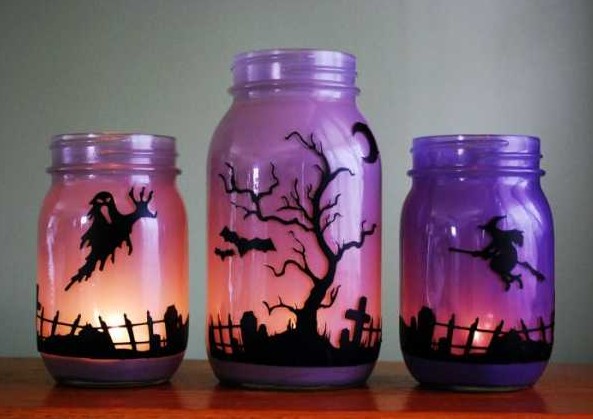
Acrylic paint is unquestionably one of the most adaptable art materials available. It may be used to paint on a variety of surfaces, including paper, canvas, wood, porcelain, and even glass.
Its thicker texture makes it simpler to handle and work with than watercolor, and unlike oil, it doesn’t require solvents or other media. Straight out from the tube, it’s ready to use.
However, if you want to use it to paint on glass, you’ll need to perform some preliminary work. After cleaning off the various impurities like dirt and grease from the glass surface, you may use a sealer to help the paint adhere better to the surface.
After that, you may apply varnish to your final piece to make it last longer. If you skip this step, your painting will be vulnerable to peeling and flaking in the future. You may accomplish this in one of two ways: apply a sealant or bake it. Both are equally effective; in fact, you can do both if you want to be safe.
You may not use or show your work of art for the entire world to see after sealing it. We invite you to try painting on a variety of glass surfaces, including wine glasses, mirrors, and windows.
How to Use Acrylic Paint on glass (Step-By-Step Guide)
Gather Your Material:
🛠️ acrylic glass paints of choice.
🛠️ glass piece you’ll work on or a glassware.
🛠️ Brushes of your choice.
🛠️ 2 jars with clean water.
🛠️ paper towels.
🛠️ An acrylic sealer or an oven for curing.
🛠️ Latex gloves, tape, and a garbage bag to protect your work environment and glass from skin oil.
🛠️ An acrylic medium for fixing the paint on the glass.
🛠️ Sandpaper.
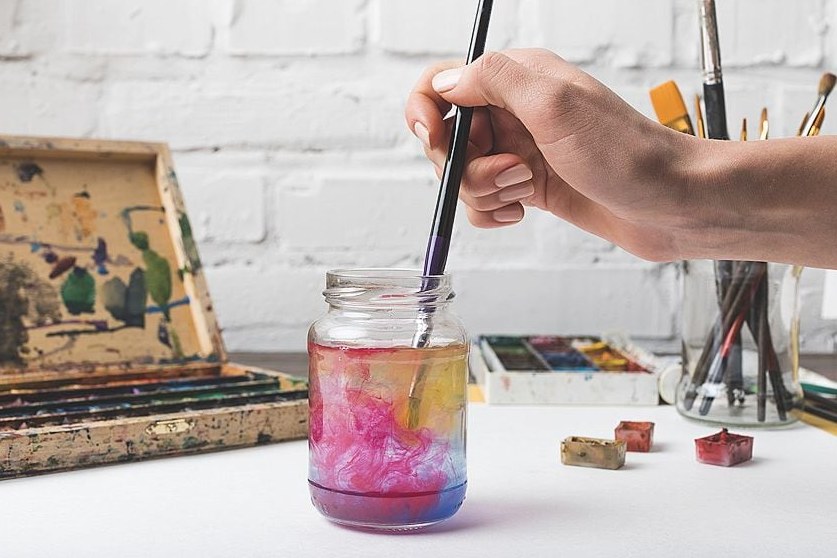
Step 1: Get the glass surface ready for painting
Make sure your surface is ready before you start painting with acrylic paint on glass. Wear gloves to avoid leaving oil residues on your skin.
Clean the surface with soapy water, and then dry it before wiping it down with rubbing alcohol or white vinegar and allowing it to air dry again. It is advisable to Tape any of the parts you don’t want to get paint on.
Apply a layer of the primer, Krylon K01305 to the glass or the area where you’ll be painting. It will make it easier for the paint to adhere to the glass. The priming layer will also help the paint to be more opaque. You may also sand the glass before applying primer to improve adherence.
Step 2: Prepare the Paint
Before painting on glass, dilute the acrylic colors or use fluid paint. Some painters like to use only water, while others prefer to use thinners like, US Art Supply 16-Ounce Pint Airbrush Thinner If you’re still worried about the paint sticking to the surface, you may use US Art supply thinner to thin it out. This medium should be premixed with the paint at a ratio of 10% paint to 90% media.
An artist’s flat brush, synthetic, or bristle brush is a suitable choice for acrylic painting on glass since they are intended to carry more acrylic than other types of bristles. Make sure the acrylic paint you’re using is suitable with the surface you’re painting on.
Some of the best paints to use are- FolkArt Gloss Finish Acrylic Enamel, ARTEZA Craft Acrylic Paint and Magicfly Acrylic Paint Set. These paints are vivid, thick, and creamy paints are beautifully colored. These paints mix well, glides smoothly, and dries rapidly.
This enamel acrylic paint dries to a tough, scratch-resistant gloss surface. To cure, bake on the top shelf of the oven. This mixture is dishwasher safe once it has been cured.
Step 3: Place the design
Step 4: Dry Properly
Various paints take different amounts of time to dry. Acrylic paint on glass typically takes an hour to cure. The drying process for certain enamel paints might take up to a week before they are fully dried. The glass should be put out in a warm, sunny area to completely dry out the paint.
When acrylic paint dries, will it attach to glass? Yes, although baking or sealing can help to improve this. Applying a sealer gives further protection and baking the glass artwork has various advantages. We’ll go through these in more detail later.
Step 5: Sealing the Acrylic Paint on Glass
Acrylic paint on glass may be sealed in two ways. You may either bake the object or use a sealer to protect it. Both approaches can be used for added security. Sealants are good to use for simply aesthetic goods, however they aren’t recommended for food or drinking glasses. The method of baking in the oven is commonly recommended since it gives the finest long-term durability and protection.
The painted glass surface can be sealed with a sealer that can be brushed on or sprayed on. Spraying sealers is recommended since there are reduced chances of touching the newly painted glass .Just make sure you know what kind of sealant you’re using before you start applying it.
Spraying should always be done in a well-ventilated location, since there might be strong odors. Spray the sealant liberally over the whole surface, being careful not to concentrate too hard on any one spot. The goal is to achieve a smooth, even finish.
Mod Podge CS11201 Waterbase Sealer and Aleene’s 26412 Spray Gloss Finish are the two best sealers you can use.
Step 6: Bake Acrylic Paint in the Oven
Some acrylic paints include instructions on how to bake them and at what temperature they should be baked. Always double-check this. Always start with a cold oven when baking glass. The glass has to heat up slowly and will be damaged if placed in a hot oven right once.
Preheat the oven to 350 degrees Fahrenheit and bake the glass for around half an hour after it reaches the desired temperature. Then turn off the oven and let the glass cool. Once the oven has totally cooled, open the door and remove the glass.
How Do You Maintain/Clean Your Acrylic Painted Glassware?
There are a few things to consider in order to give your painted work the best chance of surviving. Prepare the surface of the glass by washing it down and applying a primer before you begin painting it. This is due to the fact that painting glass is not an easy task. Any debris or fingerprints on the glass might exacerbate the problem.
Wipe out the glass with a clean cloth to eliminate anything that might affect the paint’s adherence and longevity. After you’ve finished priming the glass, let it cure for at least an hour before you start painting it. This adds a layer of protection and boosts the longevity of the product. Allow for at least 24 hours of drying time after painting the glass before curing.
Once the painted glass product has dried, make sure to cure it thoroughly. Cure glassware that will be washed in the top rack of the dishwasher in the oven; air-dry cured glassware is not safe to use in the top rack of the dishwasher.
After the glass has cured, wash it by hand with mild dish soap or place it on the top rack of the dishwasher for oven-cured goods. Do not soak anything that has been painted.
Is Acrylic Paint Safe for Windows?
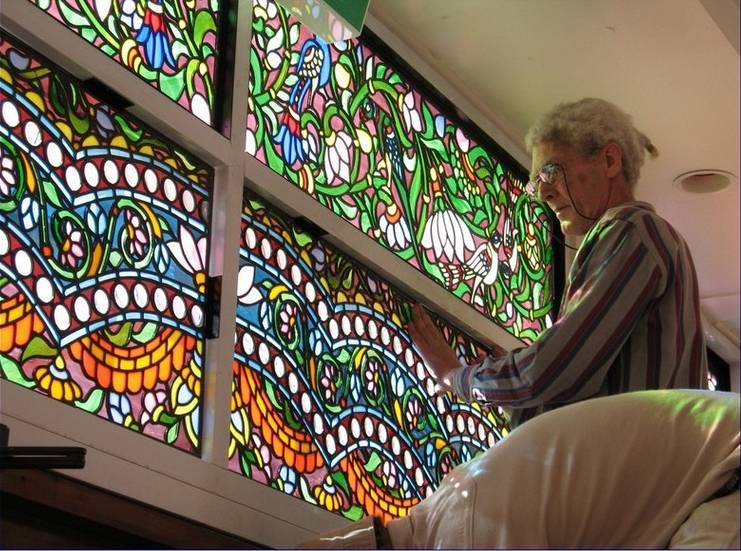
The fundamental purpose of a glass window is to create transparency. In other words, people often want light or the warmth of the sun to stream in through their glass windows. Painting a glass window, on the other hand, might make it more vibrant.
Using opaque acrylic paint, for example, inhibits light from passing through your glass window surface.
If you wish to keep light out of your windows, paint them with acrylic opaque paint. Painting glass windows with opaque acrylic paint hues may bring color to a space while also providing some seclusion. If you want to add color to your windows while still allowing light to pass through, use a translucent resin-based paint.
Frequently Asked Questions (FAQs)
Get your Answers Here
1. Can acrylic paint be removed from glass?
You must saturate acrylic paint from a window or other glass surface in order to remove it. Just make sure you don’t overdo it with the water; it shouldn’t run down the side of your glass. After the water has soaked into the paint, use a razor blade or an old plastic credit card to scrape it off.
2. Can Painted Glass be reused?
It’s a challenging task, but it’s not impossible. After you’ve applied the enamel coating, you’ll need to dissolve it properly with a solvent. One thing to bear in mind while reusing a piece of glass is that you must retreat and reheat it once again.
It is a challenging process to remove the dental enamel covering, as well as the acrylic paint that came with it. You could melt down the glass and reconstitute it if you have a home workshop with a kiln, but the paint and enamel would mix in and alter everything.
How do you keep acrylic paint from peeling off glass?
Oil is the worst enemy of paint on glass. If there is oil on the surface, acrylic paint will not fix the glass. While I provided instructions for cleaning the glass on your own, regular washing may not be sufficient to remove all of the oil.
Professional painters will treat their painting in an all-purpose sealer to ensure that there will be no complications and to prevent acrylics from clinging to glass. Before you start painting, let this first layer of sealant cure for at least 24 hours.
Conclusion:
Working with acrylic paint appeals to many people because of its flexibility. This creative material may be applied to a number of different surfaces, including glass. These paints are easy to work with and can stick to even the smoothest surfaces because of their thick consistency. Acrylic paints may be used on many different surfaces and materials, including glass.
Enamel paint is great for acrylic painting on glass because it is durable and adheres nicely to flat surfaces. Despite the fact that these paints are compatible with glass, the glass must be carefully prepared before painting. Just make sure that the glass is free of grime, dust, and oils before and you are good to go.



